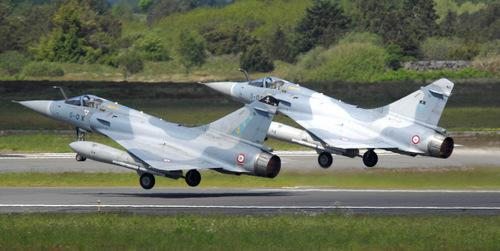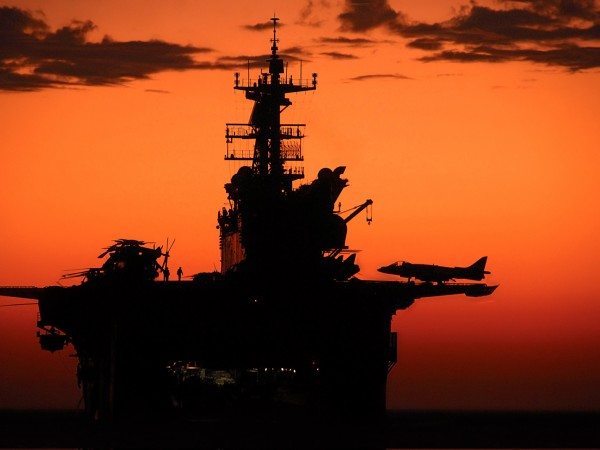RAF Top Guns will team up with their French counterparts to spearhead a major military exercise which starts on Sunday. (6 October)
The 11-day event will see aircraft from Britain, France, the United States, Canada and Germany being hosted at RAF stations for a UK wide tri-service training exercise for operations.
And building on the continuing defence cooperation between the UK and France, a Combined Joint Anglo-French Expeditionary Force will be exercised at RAF Leeming in North Yorkshire under the codename Exercise Capable Eagle which will host the operation of French Air Force (FAF) Mirage 2000N aircraft and RAF Typhoons.
The RAF’s Joint Force Air Component (JFAC) operating from RAF High Wycombe in Buckinghamshire, with augmentation from FAF personnel, will for the first time in a Joint Warrior Exercise, simulate the role of Command and Control over live air forces.
Chief of the Air Staff Air Chief Marshal Sir Andrew Pulford said:
“This is the first time that the British and French air forces will have conducted a combined end-to-end exercise. Recent operations have demonstrated the tangible benefits of French and British airmen and women working closely together, at all levels, and I know that this exercise will provide the opportunity to further enhance the ability of two of NATO’s major partners to take a leading role in future multinational operations.
The twice yearly Exercise Joint Warrior is assessed to be one of the largest tactically focused military exercises in Europe and more than 40 RAF aircraft are expected to take part including:
- Air to Air Refuelling Tankers based at RAF Brize Norton in Oxfordshire
- Tornado GR4s from RAF Lossiemouth in Scotland and RAF Marham in Norfolk
- Typhoons from RAF Leuchars in Scotland flying from RAF Leeming in Yorkshire
- Hawks from RAF Leeming in Yorkshire
Aircraft from other nations participating include:
- French Air Force Mirage 2000 F5s flying directly from Luxeuil in France with their own KC135 tanker support and Mirage 2000Ns flying from RAF Leeming.
- Maritime Patrol Aircraft (MPA) from the United States, Canada, France and Germany hosted by RAF Lossiemouth.
The exercise has been planned primarily by RAF and Naval personnel from the Joint Tactical Exercise Planning Staff (JTEPS) based at Northwood HQ, London.
JTEPS RAF spokesman Wing Commander Steve Boyle said: “To meet the participant nations training needs Joint Warrior simulates a very broad range of evolving crisis and conflict scenarios that could be realistically experienced in current and recent operations.
“These include disputes between multiple sovereign nations, internal disputes, smuggling, piracy and terrorist activity.
“The exercise will develop over two weeks, through a period of military and political tension into simulated warfighting and, potentially, hostilities; all of which generate quality training opportunities for Exercise participants to practice and improve procedures that are increasingly required of today’s modern Armed Forces.”
Exercise Joint Warrior 2013 will take place across the UK including live ranges. Among those running the air battlespace include the London and Scottish Air Traffic Control Centres and the Control and Reporting Centre at RAF Boulmer in Northumberland.
They will take part with sea and land-based units in a series of scenarios including counter insurgency operations, responses to incidents of state sponsored terrorism, and anti-drugs and piracy missions as well as state on state conflict situations.
Among the joint operations and training taking place are:
- Composite Air Operations – where aircraft of different types and roles from UK and allied air forces fly from varied locations and combine into one package
- Close Air Support – where UK and allied aircraft, occasionally using live weapons, practice supporting troops on the ground.
- Intelligence Surveillance Target Acquisition and Reconnaissance (ISTAR) – where RAF aircraft collect and disseminate digital imagery and video and send it to other Air, Land and Maritime units so they can understand the battle space in which they are operating.
- Electronic Warfare (EW) Training – This important aspect of military air operational training will primarily be undertaken at RAF Spadeadam in Cumbria and from mobile EW emitters in Northumberland.
- Anti-Submarine Warfare
- Joint Fires – Involving the live firing of Naval Gunfire, Fast Air and land based mortars in the Cape Wrath Weapons Range area
- Counter Piracy, Narcotics and Insurgency – where Naval and Air participants work together to detect and deter pirates and maritime criminals.
Background Information
Exercise Joint Warrior Area of Operation
Exercise Joint Warrior will take place across the UK utilising live ranges and Managed Danger Areas (MDAs) – see graphic below. Partners in battlespace provision include: QinetiQ (for multiple range locations), London & Scottish Air Traffic Control Centres and the Control & Reporting Centre at RAF Boulmer in Northumberland.
Exercise Joint Warrior Operations and Training
The Exercise Joint Warrior series of exercises provide opportunities for training in the warfighting disciplines such as:
GPS Denial Operations
Temporary radar and communications jamming is routinely practised in military exercises and is an essential part of preparation for operations. As such it is an important part of Exercise Joint Warrior. GPS jamming during the exercise will be limited to a confined area in North West Scotland. While such activity is not universally welcomed, as for all jamming exercises, the relevant authorities, including aviation and maritime communities have been consulted. This has resulted in a risk assessment to minimise the impact of such activity and put robust procedures in place for any unforeseen eventuality.
Logistics Support and Training
None of this significant military activity can be sustained without comprehensive logistics support and Exercise Joint Warrior offers participants the opportunity to plan and exercise all aspects of this vital skill for instance, the air participants will be able to practice their in flight re-fuelling using the various air-to-air re-fuelling tankers.
Environment
Some of the Exercise Joint Warrior exercise areas overlap environmentally sensitive conservation zones, which contain a wide variety of marine wildlife, sea bird breeding grounds and protected fauna and flora. Against this background, the MOD recognises the impact of military activity and takes its environmental responsibilities very seriously. During the planning of the exercise, Environmental Impact Assessments will be produced where required. Furthermore, close working relationships with landowners, combined with engagement with local communities, ensure that appropriate environmental mitigation procedures are put in place and then adhered to. The MOD has stated that environmental considerations will always be considered when planning exercises to meet training objectives; this direction remains a primary consideration throughout exercise planning and execution.











